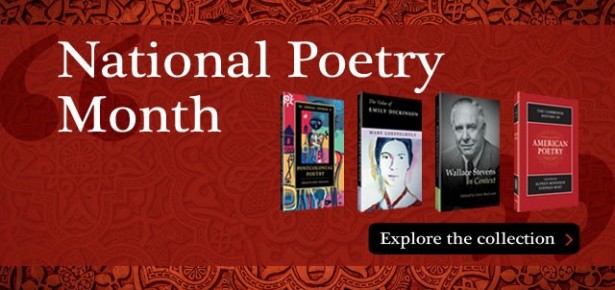
The Cambridge Companion to Modern American Poetry, edited by Walter Kalaidjian, provides a sophisticated introduction to the rich archive of modern verse produced over the past century beginning with “the New Poetry” following the fin de siècle in John Timberman Newcomb’s discussions of Stephen Crane, Edwin Arlington Robinson, and Edna St. Vincent Millay up through Robert Frost and Wallace Stevens.
In addition, it offers Bart Brinkman’s richly illustrated archival study of Amy Lowell’s and Edna St. Vincent Millay’s verse “scrapbooks” followed by Alan Golding’s close readings of such “experimental” modernists as Ezra Pound, Hilda Doolittle, T. S. Eliot, and Gertrude Stein in the early 20th Century. In this vein, the collection presents Cary Nelson’s study of the avant-garde scene in New York City examining the influences of the 1913 Armory Show, New York Dada, and the visual arts on poets such as William Carlos Williams, Mina Loy, and Baroness Elsa von Freytag-Loringhoven, leading to Anne Dewey’s discussions of the American long poem genre in the work of Ezra Pound, Hilda Doolittle, T. S. Eliot, Hart Crane, Wallace Stevens, and Melvin Tolson.
James Smethurst’s chapter on American modernism and the Harlem Renaissance features the writing of Fenton Johnson, Jean Toomer, Langston Hughes, Claude McKay, Nella Larsen, and Jessie Fauset, among others. Individual chapters on other poetic circles, centers, and movements include Rachel Blau DuPlessis’s focus on the “Objectivist” poetry of Charles Reznikoff, Carl Rakosi, George Oppen, Basil Bunting, Lorine Niedecker, Williams, and Kenneth Rexroth; Alan Wald’s revisiting of Popular Front Political of Genevieve Taggard, Herman Spector, John Wheelwright, Lucia Trent, Kenneth Fearing, Joseph Kalar, Edwin Rolfe, Sol Funaroff, Langston Hughes, and Muriel Rukeyser, among others; and Kieran Quinlan’s account of the contemporaneous poetics of the Southern Fugitive Poet’s group including John Crowe Ransom, Allen Tate, Donald Davidson, and Robert Penn Warren.
Stephen Burt considers a spectrum of several mid-century modernist poets such as Theodore Roethke, Elizabeth Bishop, Randall Jarrell, Anthony Hecht, and James Merrill. In “American Confessional Verse,” Michael Thurston discusses a group of poets led by such figures as Robert Lowell, W.D. Snodgrass, and John Berryman defined by what M. L. Rosenthal characterized in a 1959 review as “confessional poetry.” Considering poetic movements of the 1950s and 1960s, Kaplan Harris focuses on the American avant-garde aesthetic scene of Black Mountain College that included such luminaries Charles Olson, the college’s rector from 1951-1956, Robert Creeley, Robert Duncan, Ed Dorn, Larry Eigner, and Denise Levertov, among others. Maria Damon’s account of the Beat counterculture and the San Francico Renaissance focuses on Allen Ginsberg, Jack Kerouac, William Burroughs, and later, Frank O’hara and Gregory Corso, as well as Amiri Baraka’s (LeRoi Jones) and Diane di Prima’s collaborations for the little magazines Yugen and The Floating Bear.
Evie Shockley provides an overview of the Black Aesthetic Movement discussing poets such as Gwendolyn Brooks, Baraka, Nikki Giovanni, Sonia Sanchez, and Etheridge Knight as well as later poets such as Lucille Clifton, Yusef Komunyakaa, and Rita Dove, and the Darkroom Collective poet Kevin Young and Pulitzer Prize winner Natasha Trethewey. Ed Brunner’s overview of American Surrealism, the New York School and “Deep Image” Poetry considers poets as diverse as John Ashbery, Frank O’Hara, Jackson Pollock, Larry Rivers, Jasper Johns, and Robert Rauschenberg, but also Barbara Guest, Kenneth Koch, James Schuyler, Ted Berrigan, Diane Wakoski, Ron Padgett, and Alice Notley, among others. Janet McAdams foregrounds the importance of space and place in reviewing the indigenous American poetics of figures such as Simon Ortiz (Acoma Pueblo), Diane Glancy (Cherokee), Linda Hogan (Chickasaw), Deborah Miranda (Esslen-Chumash), Gladys Cardiff (Eastern Band Cherokee), and Layli Long Soldier (Oglala Lakota). Yunte Huang begins “Transpacific and Asian American Counterpoetics” by reviewing the Orientalist legacy in modern American poetry and reads the politically charged verse of Carlos Bulosan and Jose Villa examining their legacy in the work of contemporary poets such as Theresa Cha, Frances Chung, Jessica Hagedorn, Mei-mei Berssenbrugge, Kimiko Hahn, Lois-Ann Yamanaka, Walter Lew, and Myung Mi Kim.
Barret Watten’s survey of “Language Poetry” begins with the inception of the Language poetry movement and offers accounts of the poetic careers of figures such as Charles Bernstein, Ron Silliman, Harryette Mullen, Susan Howe, Lyn Hejinian, Bob Perelman, Hannah Weiner, and Rae Armantrout, among others. Finally, Evan Kindley’s study “Poet-Critics and Bureaucratic Administration” provides a reading of the figure of the “poet critic” by focusing on the hybrid careers of key American modernists who were not only recognized for their achievement in verse composition but who actively had a hand in the formation and reception of modern American poetry.
Click here to read a free chapter from The Cambridge Companion to Modern American Poetry, edited by Walter Kalaidjian
Celebrate National Poetry Month with Cambridge University Press! Get 20% off this book and a select range of other titles by clicking here
Latest Comments
Have your say!